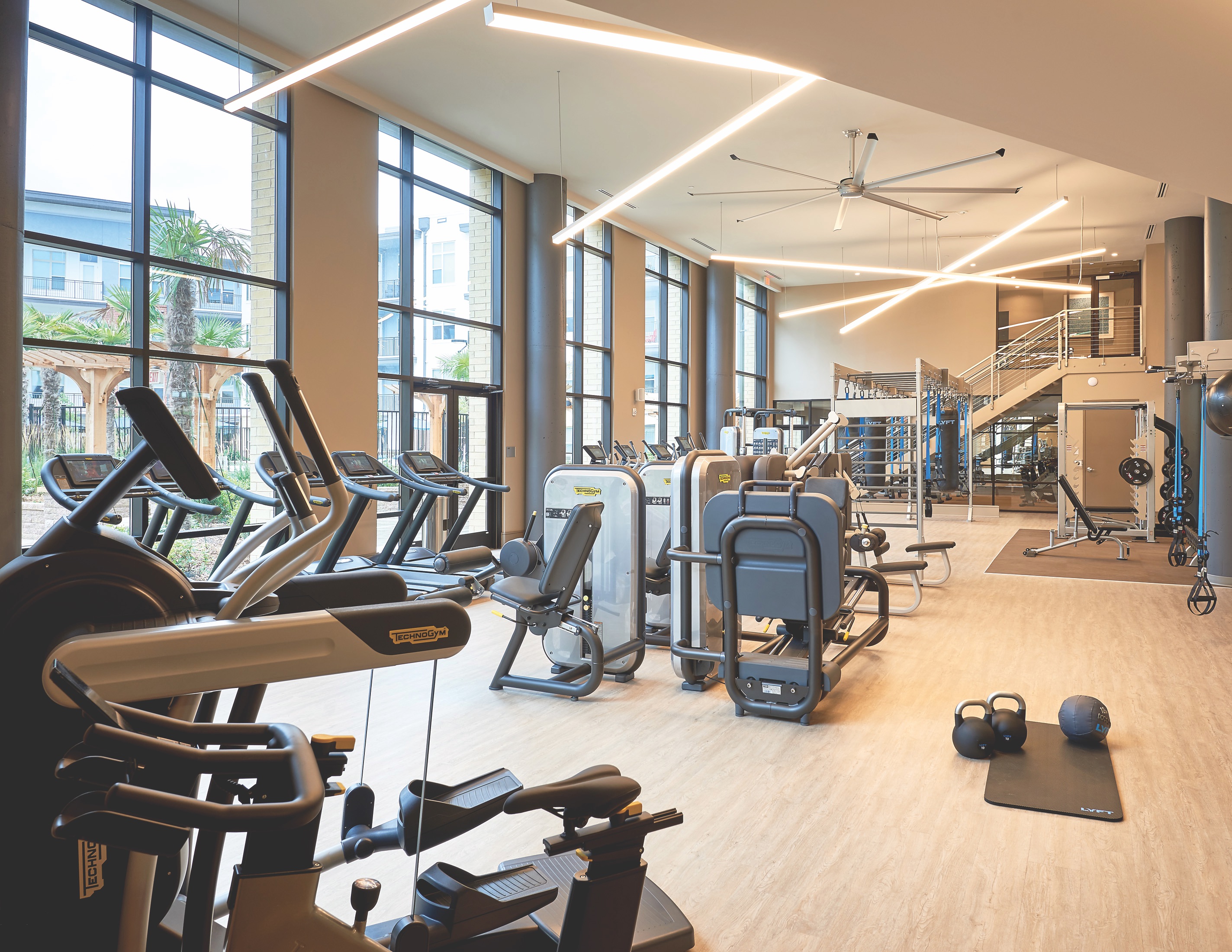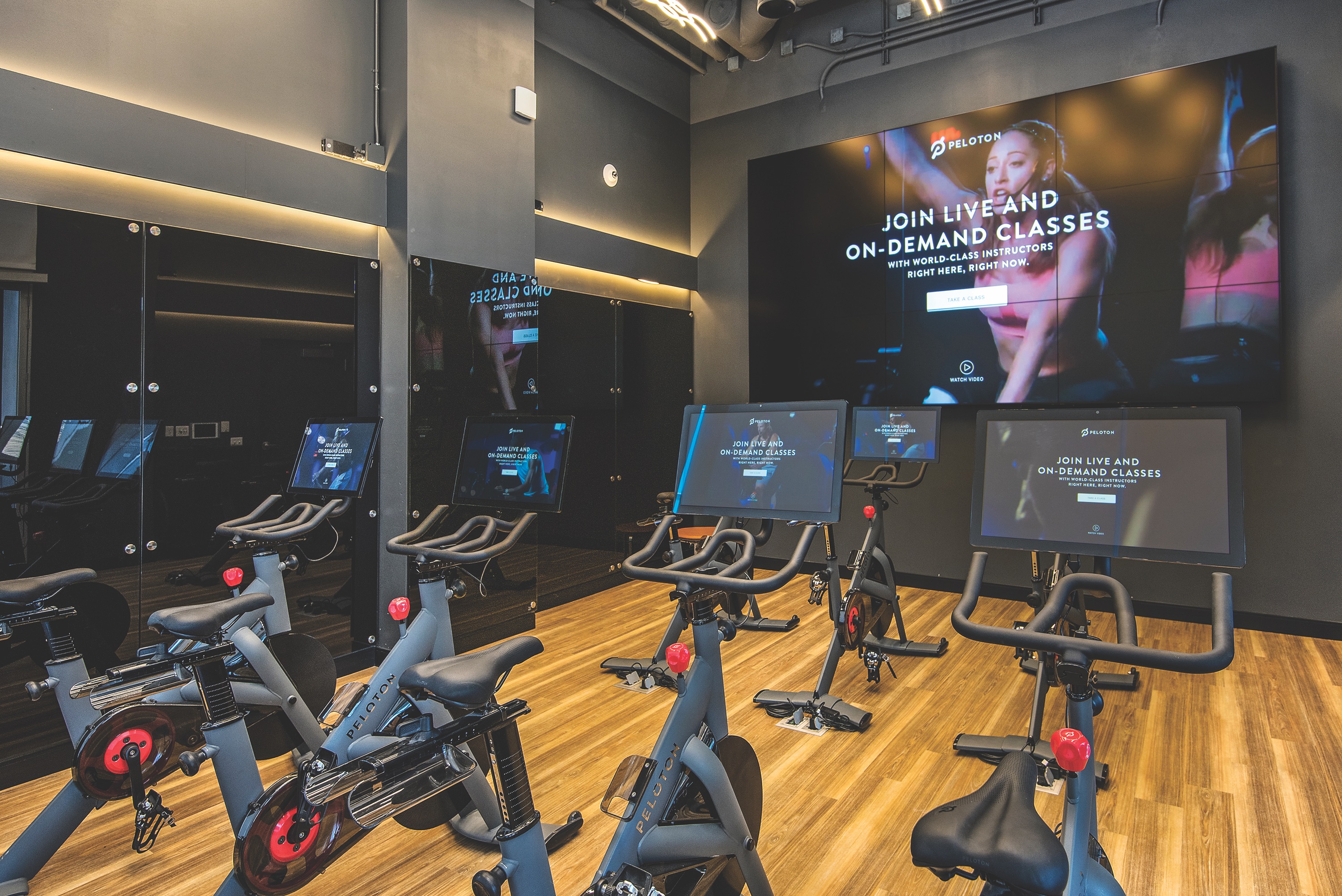With two-story windows facing an outdoor Olympic-sized pool, the fitness center at the Inspire Southpark apartment complex in Charlotte, N.C., is a stunning showpiece. It’s no accident the 4,350-sf fitness facility is located right near the leasing office. The developers, Bond Companies and Morgan Holdings, view amenities, especially fitness, health, and wellness facilities, as central to the appeal of their multifamily properties.
“We actually design around the amenity spaces,” said Ryan Morgan, Project Manager with Morgan Holdings. “We’re trying to establish communities with micro-experiences.” Inspire Southpark, along with the 366-unit Spoke Apartments, in Chicago’s River West area, caters to active adults who want a variety of exercise options.
Morgan said he sees some multifamily developers building fitness centers “just to check a box.” That won’t work with Millennials, many of whom grew accustomed to top-notch fitness facilities in college. Baby Boomers, too, are committed to fitness, health, and wellness.
An October 2017 survey by the National Multifamily Housing Council and Kingsley Associates found that 55% of renters said they would not sign a lease in an apartment building that lacked a fitness center.
Fitness facilities offer multifamily dwellers expedience and value, said Rob Bond, President, Bond Companies. “If we can save someone a half-hour by not having to commute to a health club, that’s a real convenience,” he said. This is especially true if the facility matches or exceeds the local upscale fitness spa and is free to tenants.
Creating a stellar fitness center often requires the skills and expertise of an outside design consultant. “We’ll never be as good at it as the people who do it all day long, every day of the week,” Bond said.
Fitness equipment distributors and fitness facility designers can advise on sizing, configuring, and outfitting fitness centers. Karl Smith, DHEd, Director of Residential Well Living for developer Cortland, typically seeks bids from three leading fitness equipment distributors when designing fitness facilities for a new apartment complex. Engaging with these firms is a great way to stay current with fitness trends, what competitors are offering, and how your next multifamily offering can differentiate itself in the fitness realm, he said.
Correctly sizing the space for the number and type of residents is crucial. For Bond, the rule of thumb is at least 10 sf of fitness space per dwelling unit. When planning new properties, Cortland, which owns 137 rental properties in 21 markets, uses a formula that includes average number of adults per unit and the percentage of those projected to be regular gym users. In renovations, the size of the fitness area is usually restricted to the existing space, said Smith, but on rare occasions it may be possible to knock down a wall to gain more space.
New and renovated fitness areas should have a minimum of two distinct areas—one for strength training and cardio equipment, another for classes such as Zumba, Nia, Pilates, and yoga. Ideally, the classroom space should be in a dedicated room; where closed-off space is not feasible, providing open space within the strength/cardio area is an alternative. Cortland specifies a minimum of 500 sf to be allocated for open class space. Some properties provide residents free classes as an incentive.
 Inspire Southpark, Charlotte, N.C., has a wellness center with vaulted ceiling, indoor/outdoor yoga rooms, and a WELLBEATS spin room. The adjacent spa offers nail services, massage therapy, and a sauna. A 25-meter pool and one-acre private park add to the property’s health and wellness theme. Photo: Dustin Peck Photography.
Inspire Southpark, Charlotte, N.C., has a wellness center with vaulted ceiling, indoor/outdoor yoga rooms, and a WELLBEATS spin room. The adjacent spa offers nail services, massage therapy, and a sauna. A 25-meter pool and one-acre private park add to the property’s health and wellness theme. Photo: Dustin Peck Photography.
A well-designed fitness center should have a space set aside for functional training—exercises that allow individuals to perform the activities of daily life more easily and without injuries. Functional training is a hot trend for both young adults and those over 50. Millennials gravitate toward vigorous activities using gear such as infinity ropes, heavy bags, pull-up bars, and jump targets. For seniors, functional training means lighter activity using dumbbells, stability balls, balance boards, and the like. “People 60 and over are not into the fad aspect of fitness and wellness,” Smith said. “They’re looking for functionality, ease of use, safety, and time efficiency.”
Both Cortland and Bond/Morgan properties provide equipment with fitness-on-demand training capability. Touch-screen kiosks on Cortland fitness center walls offer 600 classes on demand. Cortland surveyed 600 tenants and found that 71% said yoga would be their top choice for active play, followed by kickboxing (56%), boot camp (52%), Zumba (50%), and spinning (46%). Dead last: running clubs.
Cortland relies on design consultants to ensure its fitness spaces not only are ADA compliant but also to “make sure every piece of equipment can fit in the fitness center the way we need it to,” Smith said. Certain pieces of equipment can’t be placed next to mirrors, as their movement could cause the equipment to collide with the glass.
“The goal used to be to throw a lot of equipment into the fitness center,” Smith said. “Now it’s more about the functionality and openness of the layout.” Smith said it’s important to have not only enough equipment but also the right mix of equipment so as to minimize waits. For example, most people use cardio equipment such as stationary bikes for longer periods than they use strength-training equipment. So you need to be aware of the typical turnover time on the equipment you order.
See Also: Topsy-turvy: Creative use of air rights results in a model of urban luxury design
In designing new fitness spaces, keep in mind high ceilings, large windows, and proper lighting. LED tape that can change colors is a great way to set moods, said Morgan. The choice of music must also fit the activity—soothing tones for yoga, upbeat tunes for spin classes. Bright wall colors are usually best for active areas, while more subdued hues are preferable for meditation and yoga spaces.
Flooring also varies according to use. “For yoga, you want a somewhat squishy floor,” meaning resilient flooring, Morgan said. Floors in strength and cardio spaces should be firm.
To some, it may seem like spending considerable effort and resources on fitness amenities is wasteful, but that NMHC/Kingsley survey found that 82% of renters said they’re at least “interested” in a fitness center when choosing an apartment community.
“We think we’re getting payback from the value proposition of our amenities,” Bond said. “The idea is to get residents thinking, ‘I’m living in a luxury community, why would I want to live anywhere else?”
Related Stories
| Jan 27, 2011
Perkins Eastman's report on senior housing signals a changing market
Top international design and architecture firm Perkins Eastman is pleased to announce that the Perkins Eastman Research Collaborative recently completed the “Design for Aging Review 10 Insights and Innovations: The State of Senior Housing” study for the American Institute of Architects (AIA). The results of the comprehensive study reflect the changing demands and emerging concepts that are re-shaping today’s senior living industry.
| Jan 21, 2011
Harlem facility combines social services with retail, office space
Harlem is one of the first neighborhoods in New York City to combine retail with assisted living. The six-story, 50,000-sf building provides assisted living for residents with disabilities and a nonprofit group offering services to minority groups, plus retail and office space.
| Jan 21, 2011
Nothing dinky about these residences for Golden Gophers
The Sydney Hall Student Apartments combines 125 student residences with 15,000 sf of retail space in the University of Minnesota’s historic Dinkytown neighborhood, in Minneapolis.
| Jan 21, 2011
Revamped hotel-turned-condominium building holds on to historic style
The historic 89,000-sf Hotel Stowell in Los Angeles was reincarnated as the El Dorado, a 65-unit loft condominium building with retail and restaurant space. Rockefeller Partners Architects, El Segundo, Calif., aimed to preserve the building’s Gothic-Art Nouveau combination style while updating it for modern living.
| Jan 21, 2011
Upscale apartments offer residents a twist on modern history
The Goodwynn at Town: Brookhaven, a 433,300-sf residential and retail building in DeKalb County, Ga., combines a historic look with modern amenities. Atlanta-based project architect Niles Bolton Associates used contemporary materials in historic patterns and colors on the exterior, while concealing a six-level parking structure on the interior.
| Jan 20, 2011
Worship center design offers warm and welcoming atmosphere
The Worship Place Studio of local firm Ziegler Cooper Architects designed a new 46,000-sf church complex for the Pare de Sufrir parish in Houston.
| Jan 19, 2011
Baltimore mixed-use development combines working, living, and shopping
The Shoppes at McHenry Row, a $117 million mixed-use complex developed by 28 Walker Associates for downtown Baltimore, will include 65,000 sf of office space, 250 apartments, and two parking garages. The 48,000 sf of main street retail space currently is 65% occupied, with space for small shops and a restaurant remaining.
| Jan 7, 2011
Mixed-Use on Steroids
Mixed-use development has been one of the few bright spots in real estate in the last few years. Successful mixed-use projects are almost always located in dense urban or suburban areas, usually close to public transportation. It’s a sign of the times that the residential component tends to be rental rather than for-sale.
| Jan 4, 2011
An official bargain, White House loses $79 million in property value
One of the most famous office buildings in the world—and the official the residence of the President of the United States—is now worth only $251.6 million. At the top of the housing boom, the 132-room complex was valued at $331.5 million (still sounds like a bargain), according to Zillow, the online real estate marketplace. That reflects a decline in property value of about 24%.















